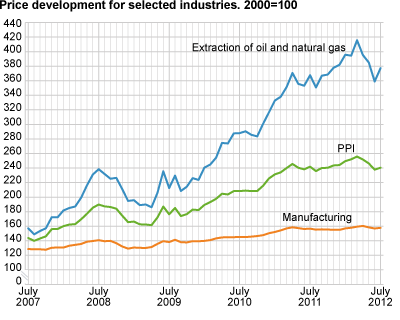Content
Published:
This is an archived release.
Higher oil prices pulled PPI up
The Producer price index (PPI) increased by 1.1 per cent from June to July 2012. Rise in oil prices pulled the total index up, while lower electricity prices dragged it in the opposite direction.
Prices within extraction of oil and natural gas increased by 4.6 per cent from June to July. The main cause for the price rise was a higher oil price in July than the month before. The price of crude oil (Brent Blend, measured in NOK) increased by 8.5 per cent, after falling by approximately 20 per cent from March to June. Prices of natural gas, on the other hand, experienced a small decrease from June to July.
Electricity prices decreased 23.3 per cent from June to July. Both lower system price from Nord Pool and cheaper electricity sold to Norwegian households explain the price decrease. The system price dropped by over 45 per cent from June to July and reached a historical low level of just 102.52 NOK/MWh. The main reasons for this were the high inflow and precipitation combined with high reservoir levels that led to high unregulated hydro power production.
Weak price increase in Norwegian manufacturing
Manufacturing prices went slightly up from June to July. Food products and refined petroleum products contributed the most with a price increase of 1.0 and 3.1 per cent respectively. The price rise in food products came from higher prices in all product groups in the domestic market. Fruits and vegetables, cereals and cereal products as well as feeding stuff for animals were groups with the greatest price increase from June to July. A decrease in export prices of processed fish and fish products, however, dampened the price growth in food products.
The price rise in refined petroleum products was largest in the export market, and was caused by higher prices for a range of petroleum products, such as gas oil, heating oil and gasoline.
Basic metals together with chemical and pharmaceutical products were two main industries that helped to curb the price rise in manufacturing. The fall in prices of basic metals of 1.4 per cent was caused by lower prices of iron and steel, as well as non-ferrous metals. A price decline in basic chemicals was the main reason behind the lower prices in chemical and pharmaceutical products.
Lower prices over the last twelve months
The PPI fell by 0.6 per cent from July 2011 to July 2012. As in June, the main reasons for decrease in the total index over the last twelve months were a fall in electricity prices, as well as lower prices in basic metals. Prices in these groups decreased by 41.6 and 10.1 per cent respectively.
Extraction of oil and natural gas together with food products were two industries that dampened the decline in the PPI from July 2011 to July 2012. Prices in these industries grew by 2.2 and 2.4 per cent respectively.
| July 2012 | Changes, per cent | ||||||||||||||||||||||||||||||||||||||||||||||||||||||||||||||||||||||||||||||
|---|---|---|---|---|---|---|---|---|---|---|---|---|---|---|---|---|---|---|---|---|---|---|---|---|---|---|---|---|---|---|---|---|---|---|---|---|---|---|---|---|---|---|---|---|---|---|---|---|---|---|---|---|---|---|---|---|---|---|---|---|---|---|---|---|---|---|---|---|---|---|---|---|---|---|---|---|---|---|---|
| June 2012-July 2012 | July 2011-July 2012 | ||||||||||||||||||||||||||||||||||||||||||||||||||||||||||||||||||||||||||||||
| Total index | 240.5 | 1.1 | -0.6 | ||||||||||||||||||||||||||||||||||||||||||||||||||||||||||||||||||||||||||||
| Extraction and related services | 377.3 | 4.0 | 2.6 | ||||||||||||||||||||||||||||||||||||||||||||||||||||||||||||||||||||||||||||
| Manufacturing, mining and quarrying | 157.8 | 0.6 | 0.6 | ||||||||||||||||||||||||||||||||||||||||||||||||||||||||||||||||||||||||||||
| Electricity, gas and steam supply | 155.4 | -23.3 | -41.6 | ||||||||||||||||||||||||||||||||||||||||||||||||||||||||||||||||||||||||||||
| Main industrial groupings | |||||||||||||||||||||||||||||||||||||||||||||||||||||||||||||||||||||||||||||||
| Intermediate goods | 143.7 | -0.1 | -1.4 | ||||||||||||||||||||||||||||||||||||||||||||||||||||||||||||||||||||||||||||
| Investment goods | 129.1 | 0.0 | 1.7 | ||||||||||||||||||||||||||||||||||||||||||||||||||||||||||||||||||||||||||||
| Consumer goods | 135.2 | 0.4 | 2.0 | ||||||||||||||||||||||||||||||||||||||||||||||||||||||||||||||||||||||||||||
| Energy goods | 341.9 | 2.3 | -1.5 | ||||||||||||||||||||||||||||||||||||||||||||||||||||||||||||||||||||||||||||
Additional information
Contact
-
Producer price index
E-mail: produsentpris@ssb.no
tel.: (+47) 21 09 40 00
-
Elisabeth Mælum
E-mail: elisabeth.maelum@ssb.no
tel.: (+47) 97 01 28 49
-
Morten Madshus
E-mail: morten.madshus@ssb.no
tel.: (+47) 40 90 26 94
-
Monika Græsli Engebretsen
E-mail: monika.graesli.engebretsen@ssb.no
tel.: (+47) 40 90 23 71
-
Håvard Georg Jensen
E-mail: havard.jensen@ssb.no
tel.: (+47) 40 90 26 86

